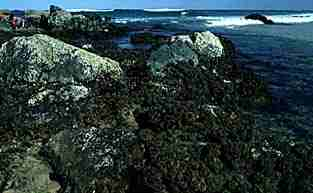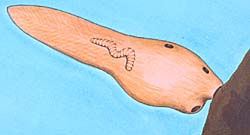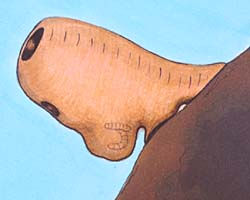|
|

Ascidians
Phylum:
Chordata

Ascidians belong to the Phylum Chordata, and are classified as Protochordates.
 Although
Ascidians do not have a vertebral column when they are adults, their juvenile
larvae show features in common with the vertebrates.
Although
Ascidians do not have a vertebral column when they are adults, their juvenile
larvae show features in common with the vertebrates.
 Free-swimming
larvae have a notochord (pre-vertebral column), a dorsal nerve
chord, and pharyngeal clefts or gill slits.
Free-swimming
larvae have a notochord (pre-vertebral column), a dorsal nerve
chord, and pharyngeal clefts or gill slits.
 These
features are lost or modified after the juvenile tadpole-like stage settles
onto a rock and then grows into the leathery adult stage.
These
features are lost or modified after the juvenile tadpole-like stage settles
onto a rock and then grows into the leathery adult stage.
The most common Ascidian on rocky ocean shores is the common Cunjevoi, Pyura stolonifera, otherwise known as the "sea-squirt". It gets its common name from its ability to squirt out a jet of sea water if stepped upon.
The flesh inside the Cunjevoi is used as fish bait by rock fishermen. When you walk across a rocky shore at low tide, you may see many cunjevoi, with many having their tops hacked off.
There are many other ascidians on shores as well, but most are usually hidden under rocks and boulders lying in sand or mud conditions. These species are more common in the marine zone below the levels reached by the lowest tides.
References
Bennett, I. (1987) W.J. Dakin's classic study: Australian Seashores. Angus & Robertson, Sydney.
Davey, K. (1998) A Photographic Guide to Seashore Life of Australia. New Holland, Sydney.
Edgar, G. J. (1997) Australian Marine Life: the plants and animals of temperate waters. Reed Books, Kew.
Quinn, G. P., Wescott, G. C. & Synnot, R. N. (1992) Life on the Rocky Shores of South-Eastern Australia: an illustrated field guide. Victorian National Parks Association, Melbourne.
Marine Research Group of Victoria (1984) Coastal Invertebrates of Victoria: an atlas of selected species. Museum of Victoria, Melbourne.
Underwood, A. J. & Chapman, M. G. (1993) Seashores: a beachcomber's guide. New South Wales University Press, Sydney.
Chordata
Ascidians
Home
Page
Taxonomy
Biogeography
Rocky Shores
Tidal Levels
Intertidal Zonation
Environmental Factors
Biological
Factors
Feeding Relationships
Activities
Glossary
References
 Life
on Australian Seashores
Life
on Australian Seashores
by Keith Davey (C) 2000
Learning Consultant
- Media
The University of Newcastle
email at australian_seashores@hotmail.com
Scientific Consultant: Phil
Colman
site created 01.01.98 : updated 01.04.2000